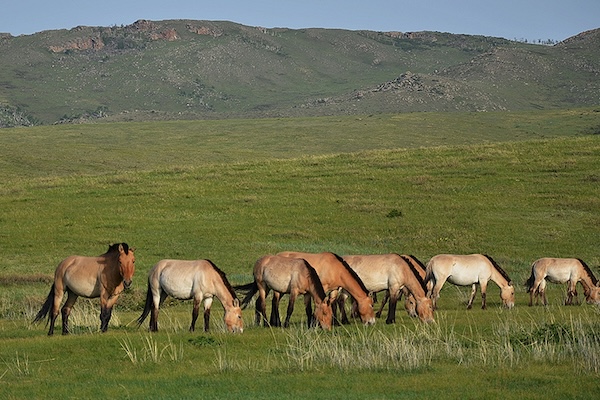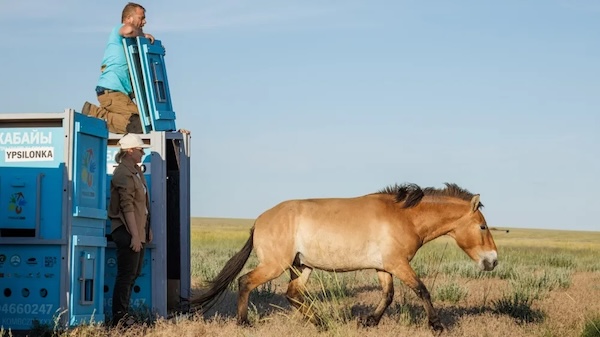The rare “Przewalski’s horse”, considered the last truly wild horse species, has been making headlines lately, and refreshingly it’s mostly all good news. Also called the “takhi” or Mongolian wild horse, their numbers had dwindled so low by the 1960s that they were declared “extinct in the wild.” However, they are making a comeback thanks to reintroduction programs, including new releases in June in their once-native lands. Przewalski’s horses have also made headlines in the US recently amid some surprise discoveries.
Fans of the American Mustang may be confused by the Przewalski’s title of the “last truly wild horse.” Experts say that just because Mustang’s roam free does not make them “wild.” The American Mustang is actually considered feral because they descend from domestic horse breeds. The original mustangs were Colonial Spanish horses that escaped captivity, though many other breeds and types of horses have contributed to the modern Mustang.
Przewalski’s horses were last seen in the wild in 1969 on the Mongolian steppes of the Gobi Desert. Mongolia is an Alaska-sized country sandwiched between China and the former Soviet Union. The species is named after a Russian colonel and explorer of Polish descent, Nikolai Przhevalsky (1839–1888) (Nikołaj Przewalski in Polish). In 1881, the horse received a formal scientific description based on Przewalski’s specimens and description.
After 1903, there were no reports of the wild population again until 1947, when several isolated groups were observed. The last observation of the wild horse in its native habitat was of a single stallion in 1969.
Luckily, breeding programs had been in place before Przewalski’s horse disappeared from the wild. In 1902, 28 fillies were captured and brought to Europe. These, along with a small number of additional captives, were distributed among zoos and breeding centers in Europe and the US. However, by the mid-1930s, inbreeding had caused reduced fertility and the captive population experienced a genetic bottleneck, with the surviving captive breeding stock descended from only 11 of the founder captives.
Just as the situation began to improve amid an increased exchange of breeding animals, World War II delivered another near-fatal blow to Przewalski’s horses. The most valuable group, in Askania Nova, Ukraine, were all shot by German soldiers during WW II occupation, while the group in the US died out. Only two captive populations in zoos remained, in Munich and in Prague, and of the 31 remaining horses at war’s end, only 9 became ancestors of the subsequent captive population. By the end of the 1950s, only 12 individual horses were left in the world’s zoos.
As luck would have it, the Przewalski’s horses may have been saved from total extinction by a single mare captured as a foal in 1957. This mare, which would prove to be the last wild-caught Przewalki’s horse, added a much-needed genetic boost. The spread of her bloodline through the inbred captive groups led to increased reproductive success and by 1965 there were more than 130 animals spread among thirty-two zoos and parks.
Today, captive breeding programs and years of recovery practices have raised the number of Przewalki’s horses to nearly 2,000, of which around 500 are free-roaming. Most recently, seven Prezewalki’s were returned to their native habitat on a preserve in Kazakhstan, thanks to efforts by the Prague Zoo. The zoo previously organized the return of several horses to Mongolia and, over the next five years, aims to transport a total of 40 Przewalski’s horses to central Kazakhstan.
Przewalki’s horses have also been generating headlines inside the US recently. At the University of Minnesota, researchers reported that they have mapped the complete genome of the endangered horse. The genome is critically important to the conservation and continued survival of these rare horses. Researchers are already using it to make predictions about what various gene mutations could mean for the breed’s health and conservation.
Over in Utah, a horse surrendered to the Lazy B Equine Rescue and Sanctuary in early June is thought to be a Przewalski’s, which they named “Fiona.” The rescue is still waiting on DNA results to confirm their suspicions.
Another possible Przewalski ’s horse was found earlier in June by a woman in Kansas. The woman said she confirmed the breed via a DNA test, though as far as I can tell, she hasn’t made the test results public, so who knows? She apparently intends to keep the horse, which has been named “Shrek.” (Sources: Smithsonian Magazine, National Zoo, Forbes, Agdaily)










